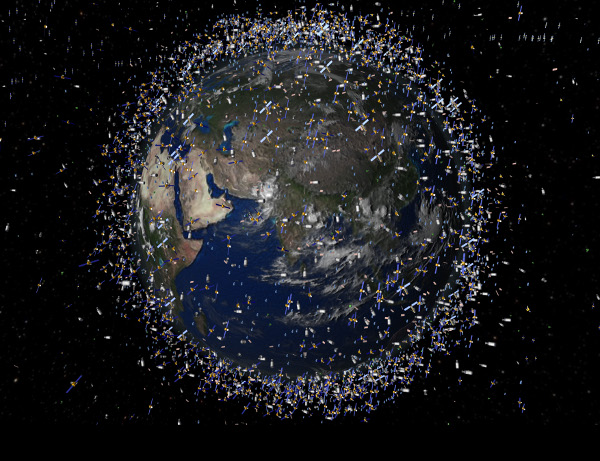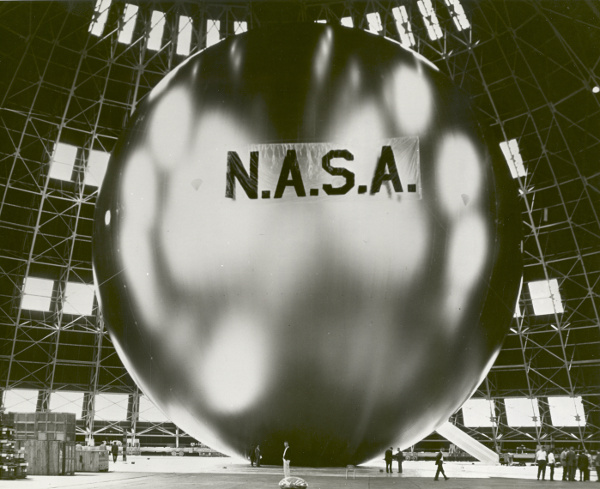| Tikalon Blog is now in archive mode.
An easily printed and saved version of this article, and a link
to a directory of all articles, can be found below: |
|
This article |
| Directory of all articles |
Danger, Will Robinson!
August 31, 2010
The phrase, "
Danger, Will Robinson!," was used only once in an episode of the 1960s television series,
Lost in Space, but it became a popular exhortation. Lost in Space was the antithesis of
Star Trek. Star Trek was generally serious business (
tribbles, aside), but Lost in Space was more like a kid's show. The
theme, however, is high quality, as is everything composed by
John Williams. Young Will Robinson faced danger from nefarious aliens and the like; but the region of space surrounding Earth is populated by orbital debris that poses a real danger to satellites and space faring humans. The problem is so current, there's an online game called Space Janitor.[1]

Satellites in Low Earth Orbit (European Space Agency).
Most newer satellites have a capability to be de-orbited after their useful life. For example, the
Compton Gamma Ray Observatory, which was launched in April, 1991, was successfully deorbited 4 June 4, 2000. Many earlier satellites did not have such capability, and others arrive at orbit dead-on-arrival, so they can't be brought into a controlled descent. Tests of
anti-satellite weapons have broken satellites into smaller pieces that pose a greater risk than a single, trackable object.
For many decades, NASA has been researching possible approaches for removal of unwanted satellites and the occasional rouge booster rocket. Some concepts, such as robotic janitors, are interesting from a science fiction standpoint, but they aren't really practical.[2] A new system, called GOLD, for Gossamer Orbit Lowering Device, proposes the use of space balloons to increase the aerodynamic drag of orbiting craft a hundredfold.[3] This would deorbit space junk quickly so it would burn in Earth's atmosphere.
Balloons in space are not a new idea. Balloons were among the first satellites.
Echo 1 and
Echo 2 were passive communications satellites designed to reflect radio signals from a low Earth orbit (
LEO). Echo 1, a 100 foot diameter metalized balloon of 0.0005-inch
Mylar (biaxially-oriented
polyethylene terephthalate), was placed into a 944-1,048 mile orbit on August 12, 1960.[4] Echo 1 remained in orbit for nearly eight years, burning on reentry on May 24, 1968.[4] The slightly larger, 135-foot diameter, Echo 2 was launched on January 25, 1964.[4] It reentered on June 7, 1969, having a somewhat shorter lifetime because of its larger drag cross-section. Such LEO satellites have limited usefulness, since they are not visible at all times, so these passive reflectors were quickly replaced by active satellites in higher orbits, and in
geosynchronous orbits.

The 135-foot diameter Echo 2 balloon satellite undergoing tests in a hanger at Weekesville, North Carolina. The satellite, when folded, fit into the 41-inch diameter canister in the foreground.
Kristin Gates of
Global Aerospace Corporation presented a paper on the GOLD balloon system at the August 2, 2010, Artificial and Natural Space Debris session of the
AIAA Astrodynamics Specialists Conference (
Toronto, Canada).[3] The balloons, very similar to the Echo satellites, are intended to enhance the atmospheric drag of unwanted orbital craft to reduce their reentry times from centuries to months. This balloon system can be integrated into the craft itself for use at the end of its useful lifetime. In that case, the system competes with a rocket-assisted reentry, but it's less expensive and weighs less. Otherwise, a balloon can be attached later by a robot craft. An important feature of the GOLD system is that it won't add to space debris if it's hit by another orbiting object. Such an object would pass through the thin balloon without breaking apart into new fragments.
References:
- National Geographic, Space Janitor Game
- Arthur H. Rotstein, "Professor Envisions High-Tech Janitor to Clean Up Space Junk," LA Times, January 1, 1995.
- Space Daily, "Safe And Efficient De-Orbit Of Space Junk Without Making The Problem Worse," August 3, 2010.
- Project Echo page on Wikipedia.
Permanent Link to this article
Linked Keywords: Danger, Will Robinson!; Lost in Space; Star Trek; tribbles; John Williams; European Space Agency; Satellites in Low Earth Orbit; Compton Gamma Ray Observatory; anti-satellite weapons; Echo 1; Echo 2; Mylar; polyethylene terephthalate; geosynchronous orbits; Global Aerospace Corporation; AIAA; Toronto, Canada.